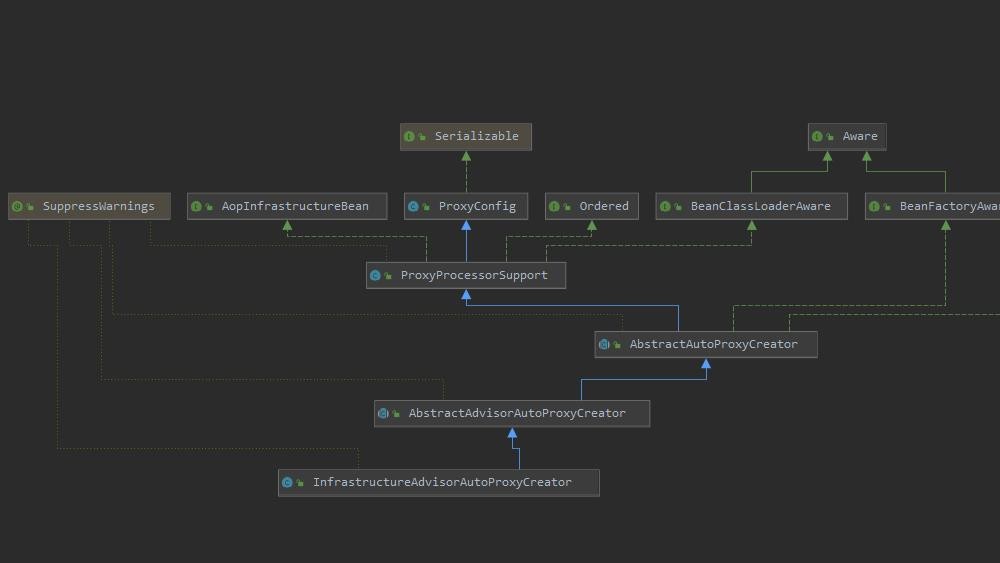Python 官方文档:入门教程 => 点击学习
前言 今天我们来讲讲spring的声明式事务。 开始 说到声明式事务,我们现在回顾一下事务这个概念,什么是事务呢,事务指的是逻辑上的⼀组操作,组成这组操作的各个单
说到声明式事务,我们现在回顾一下事务这个概念,什么是事务呢,事务指的是逻辑上的⼀组操作,组成这组操作的各个单元,要么全部成功,要么全部不成功。从而确保了数据的准确与安全。事务有着四大特性(ACID),分别是
原子性(Atomicity)原⼦性是指事务是⼀个不可分割的⼯作单位,事务中的操作要么都发⽣,要么都不发⽣。
⼀致性(Consistency)事务必须使数据库从⼀个⼀致性状态变换到另外⼀个⼀致性状态。
隔离性(Isolation)事务的隔离性是多个⽤户并发访问数据库时,数据库为每⼀个⽤户开启的事务,每个事务不能被其他事务的操作数据所⼲扰,多个并发事务之间要相互隔离。
持久性(Durability) 持久性是指⼀个事务⼀旦被提交,它对数据库中数据的改变就是永久性的,接下来即使数据库发⽣故障
也不应该对其有任何影响。
在spring中,一共有两种方式可以实现事务控制,分别是编程式事务和声明式事务。编程式事务指的是在代码中添加事务控制代码,而声明式事务指的是利用xml或者注解的形式来配置控制事务,下面就以纯注解配置声明式事务为例进行剖析。
spring开启声明式事务的注解是@EnableTransactionManagement,讲到这里首先要明白一点,spring的事务管理器管理事务其实就是利用aop的方式,通过创建动态代理加上拦截,实现的事务管理。在spring的配置类中加上这个注解,就支持了声明式事务,那么spring是怎么通过这么一个注解就可以支持事务的呢,我们来看代码。
首先我们看到,在这个注解上,import了一个selector
@Import(TransactionManagementConfigurationSelector.class)
我们看这个selector类中的这么一段代码
@Override
protected String[] selectImports(AdviceMode adviceMode) {
switch (adviceMode) {
case PROXY:
return new String[] {AutoProxyReGIStrar.class.getName(),
ProxyTransactionManagementConfiguration.class.getName()};
case ASPECTJ:
return new String[] {determineTransactionAspectClass()};
default:
return null;
}
}这段代码中,引入了AutoProxyRegistrar和ProxyTransactionManagementConfiguration这两个类,我们先来看AutoProxyRegistrar这个类,这个类中有一段这样的代码
if (mode == AdviceMode.PROXY) {
//重要的是这句代码
AopConfigUtils.registerAutoProxyCreatorIfNecessary(registry);
if ((Boolean) proxyTargetClass) {
AopConfigUtils.forceAutoProxyCreatorToUseClassProxying(registry);
return;
}
}
//我们进到这个方法中
@Nullable
public static BeanDefinition registerAutoProxyCreatorIfNecessary(
BeanDefinitionRegistry registry, @Nullable Object source) {
//可以看到引入了InfrastructureAdvisorAutoProxyCreator这个类,那么这个类又是什么呢
return registerOrEScalateApcAsRequired(InfrastructureAdvisorAutoProxyCreator.class, registry, source);
}
//先看一下
public class InfrastructureAdvisorAutoProxyCreator extends AbstractAdvisorAutoProxyCreator {
@Nullable
private ConfigurableListableBeanFactory beanFactory;
@Override
protected void initBeanFactory(ConfigurableListableBeanFactory beanFactory) {
super.initBeanFactory(beanFactory);
this.beanFactory = beanFactory;
}
@Override
protected boolean isEligibleAdvisorBean(String beanName) {
return (this.beanFactory != null && this.beanFactory.containsBeanDefinition(beanName) &&
this.beanFactory.getBeanDefinition(beanName).getRole() == BeanDefinition.ROLE_INFRASTRUCTURE);
}
}看一下继承结构图

可以看到这个方法间接继承于SmartInstantiationAwareBeanPostProcessor,最终继承于BeanPostProcessor,这说明InfrastructureAdvisorAutoProxyCreator类是一个后置处理器,并且跟 spring AOP 开启@EnableAspectJAutoProxy 时注册的AnnotationAwareAspectJProxyCreator实现的是同⼀个接口,这也对应了我之前所说声明式事务是springAOP思想的一种应用。
然后我们回过头来再看ProxyTransactionManagementConfiguration这个类,我们看到其中有一个事务增强器,一个属性解析器和是一个事务拦截器
@Bean(name = TransactionManagementConfigUtils.TRANSACTION_ADVISOR_BEAN_NAME)
@Role(BeanDefinition.ROLE_INFRASTRUCTURE)
public BeanFactoryTransactionAttributeSourceAdvisor transactionAdvisor(
TransactionAttributeSource transactionAttributeSource, TransactionInterceptor transactionInterceptor) {
// 事务增强器
BeanFactoryTransactionAttributeSourceAdvisor advisor = new BeanFactoryTransactionAttributeSourceAdvisor();
// 注入属性解析器
advisor.setTransactionAttributeSource(transactionAttributeSource);
// 注入事务拦截器
advisor.setAdvice(transactionInterceptor);
if (this.enableTx != null) {
advisor.setOrder(this.enableTx.<Integer>getNumber("order"));
}
return advisor;
}
@Bean
@Role(BeanDefinition.ROLE_INFRASTRUCTURE)
// 属性解析器
public TransactionAttributeSource transactionAttributeSource() {
return new AnnotationTransactionAttributeSource();
}
@Bean
@Role(BeanDefinition.ROLE_INFRASTRUCTURE)
// 事务拦截器
public TransactionInterceptor transactionInterceptor(TransactionAttributeSource transactionAttributeSource) {
TransactionInterceptor interceptor = new TransactionInterceptor();
interceptor.setTransactionAttributeSource(transactionAttributeSource);
if (this.txManager != null) {
interceptor.setTransactionManager(this.txManager);
}
return interceptor;
}
先看看属性解析器
//注解解析器集合
private final Set<TransactionAnnotationParser> annotationParsers;
这是一个注解解析器的集合,可以添加多种注解解析器,在这里我们主要关注的是spring事务注解解析器SpringTransactionParser,看一下相关代码
protected TransactionAttribute parseTransactionAnnotation(AnnotationAttributes attributes) {
RuleBasedTransactionAttribute rbta = new RuleBasedTransactionAttribute();
// 对应Transaction注解的相关属性
Propagation propagation = attributes.getEnum("propagation");
rbta.setPropagationBehavior(propagation.value());
Isolation isolation = attributes.getEnum("isolation");
rbta.setIsolationLevel(isolation.value());
rbta.setTimeout(attributes.getNumber("timeout").intValue());
rbta.setReadOnly(attributes.getBoolean("readOnly"));
rbta.setQualifier(attributes.getString("value"));
List<RollbackRuleAttribute> rollbackRules = new ArrayList<>();
for (Class<?> rbRule : attributes.getClassArray("rollbackFor")) {
rollbackRules.add(new RollbackRuleAttribute(rbRule));
}
for (String rbRule : attributes.getStringArray("rollbackForClassName")) {
rollbackRules.add(new RollbackRuleAttribute(rbRule));
}
for (Class<?> rbRule : attributes.getClassArray("noRollbackFor")) {
rollbackRules.add(new NoRollbackRuleAttribute(rbRule));
}
for (String rbRule : attributes.getStringArray("noRollbackForClassName")) {
rollbackRules.add(new NoRollbackRuleAttribute(rbRule));
}
rbta.setRollbackRules(rollbackRules);
return rbta;
}可以看到这段代码中的Enum和ClassArray其实正是@Transaction注解中的相关属性,这个属性解析器的作用之一就是用来解析@Transaction注解中的属性
看完了属性解析器,我们接下来看事务拦截器TransactionInterceptor,其中重要的是这段代码
@Override
@Nullable
public Object invoke(MethodInvocation invocation) throws Throwable {
// Work out the target class: may be {@code null}.
// The TransactionAttributeSource should be passed the target class
// as well as the method, which may be from an interface.
Class<?> targetClass = (invocation.getThis() != null ? AopUtils.getTargetClass(invocation.getThis()) : null);
// Adapt to TransactionAspectSupport's invokeWithinTransaction...
// 增加事务支持
return invokeWithinTransaction(invocation.getMethod(), targetClass, invocation::proceed);
}
然后我们进到这个方法里面
@Nullable
protected Object invokeWithinTransaction(Method method, @Nullable Class<?> targetClass,
final InvocationCallback invocation) throws Throwable {
// If the transaction attribute is null, the method is non-transactional.
// 获取属性解析器,在配置类ProxyTransactionManagementConfiguration配置时加入
TransactionAttributeSource tas = getTransactionAttributeSource();
final TransactionAttribute txAttr = (tas != null ? tas.getTransactionAttribute(method, targetClass) : null);
final TransactionManager tm = determineTransactionManager(txAttr);
if (this.ReactiveAdapterRegistry != null && tm instanceof ReactiveTransactionManager) {
ReactiveTransactionSupport txSupport = this.transactionSupportCache.computeIfAbsent(method, key -> {
if (KotlinDetector.isKotlinType(method.getDeclarinGClass()) && KotlinDelegate.isSuspend(method)) {
throw new TransactionUsageException(
"Unsupported annotated transaction on suspending function detected: " + method +
". Use TransactionalOperator.transactional extensions instead.");
}
ReactiveAdapter adapter = this.reactiveAdapterRegistry.getAdapter(method.getReturnType());
if (adapter == null) {
throw new IllegalStateException("Cannot apply reactive transaction to non-reactive return type: " +
method.getReturnType());
}
return new ReactiveTransactionSupport(adapter);
});
return txSupport.invokeWithinTransaction(
method, targetClass, invocation, txAttr, (ReactiveTransactionManager) tm);
}
// 获取事务管理器
PlatfORMTransactionManager ptm = asPlatformTransactionManager(tm);
final String joinpointIdentification = methodIdentification(method, targetClass, txAttr);
if (txAttr == null || !(ptm instanceof CallbackPreferringPlatformTransactionManager)) {
// Standard transaction demarcation with getTransaction and commit/rollback calls.
TransactionInfo txInfo = createTransactionIfNecessary(ptm, txAttr, joinpointIdentification);
Object retVal;
try {
// This is an around advice: Invoke the next interceptor in the chain.
// This will normally result in a target object being invoked.
retVal = invocation.proceedWithInvocation();
}
catch (Throwable ex) {
// target invocation exception
// 目标方法抛异常,会执行回滚的操作
completeTransactionAfterThrowing(txInfo, ex);
throw ex;
}
finally {
cleanupTransactionInfo(txInfo);
}
if (vavrPresent && VavrDelegate.isVavrTry(retVal)) {
// Set rollback-only in case of Vavr failure matching our rollback rules...
TransactionStatus status = txInfo.getTransactionStatus();
if (status != null && txAttr != null) {
retVal = VavrDelegate.evaluateTryFailure(retVal, txAttr, status);
}
}
// 目标方法正常运行,会执行commitTransactionAfterReturning,执行事务提交操作
commitTransactionAfterReturning(txInfo);
return retVal;
}
else {
final ThrowableHolder throwableHolder = new ThrowableHolder();
// It's a CallbackPreferringPlatformTransactionManager: pass a TransactionCallback in.
try {
Object result = ((CallbackPreferringPlatformTransactionManager) ptm).execute(txAttr, status -> {
TransactionInfo txInfo = prepareTransactionInfo(ptm, txAttr, joinpointIdentification, status);
try {
Object retVal = invocation.proceedWithInvocation();
if (vavrPresent && VavrDelegate.isVavrTry(retVal)) {
// Set rollback-only in case of Vavr failure matching our rollback rules...
retVal = VavrDelegate.evaluateTryFailure(retVal, txAttr, status);
}
return retVal;
}
catch (Throwable ex) {
if (txAttr.rollbackOn(ex)) {
// A RuntimeException: will lead to a rollback.
if (ex instanceof RuntimeException) {
throw (RuntimeException) ex;
}
else {
throw new ThrowableHolderException(ex);
}
}
else {
// A normal return value: will lead to a commit.
throwableHolder.throwable = ex;
return null;
}
}
finally {
cleanupTransactionInfo(txInfo);
}
});
// Check result state: It might indicate a Throwable to rethrow.
if (throwableHolder.throwable != null) {
throw throwableHolder.throwable;
}
return result;
}
catch (ThrowableHolderException ex) {
throw ex.getCause();
}
catch (TransactionSystemException ex2) {
if (throwableHolder.throwable != null) {
logger.error("Application exception overridden by commit exception", throwableHolder.throwable);
ex2.initApplicationException(throwableHolder.throwable);
}
throw ex2;
}
catch (Throwable ex2) {
if (throwableHolder.throwable != null) {
logger.error("Application exception overridden by commit exception", throwableHolder.throwable);
}
throw ex2;
}
}
}
总体来说,spring实现声明式事务的过程是这样的
到此这篇关于spring是如何实现声明式事务的的文章就介绍到这了,更多相关spring 声明式事务内容请搜索编程网以前的文章或继续浏览下面的相关文章希望大家以后多多支持编程网!
--结束END--
本文标题: spring是如何实现声明式事务的
本文链接: https://www.lsjlt.com/news/124004.html(转载时请注明来源链接)
有问题或投稿请发送至: 邮箱/279061341@qq.com QQ/279061341
下载Word文档到电脑,方便收藏和打印~
2024-03-01
2024-03-01
2024-03-01
2024-02-29
2024-02-29
2024-02-29
2024-02-29
2024-02-29
2024-02-29
2024-02-29
回答
回答
回答
回答
回答
回答
回答
回答
回答
回答
0